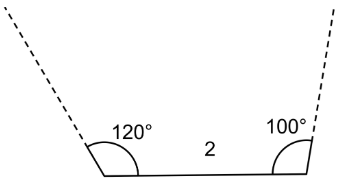7.2.4: Drawing Triangles (Part 1)
- Page ID
- 38729
\( \newcommand{\vecs}[1]{\overset { \scriptstyle \rightharpoonup} {\mathbf{#1}} } \)
\( \newcommand{\vecd}[1]{\overset{-\!-\!\rightharpoonup}{\vphantom{a}\smash {#1}}} \)
\( \newcommand{\id}{\mathrm{id}}\) \( \newcommand{\Span}{\mathrm{span}}\)
( \newcommand{\kernel}{\mathrm{null}\,}\) \( \newcommand{\range}{\mathrm{range}\,}\)
\( \newcommand{\RealPart}{\mathrm{Re}}\) \( \newcommand{\ImaginaryPart}{\mathrm{Im}}\)
\( \newcommand{\Argument}{\mathrm{Arg}}\) \( \newcommand{\norm}[1]{\| #1 \|}\)
\( \newcommand{\inner}[2]{\langle #1, #2 \rangle}\)
\( \newcommand{\Span}{\mathrm{span}}\)
\( \newcommand{\id}{\mathrm{id}}\)
\( \newcommand{\Span}{\mathrm{span}}\)
\( \newcommand{\kernel}{\mathrm{null}\,}\)
\( \newcommand{\range}{\mathrm{range}\,}\)
\( \newcommand{\RealPart}{\mathrm{Re}}\)
\( \newcommand{\ImaginaryPart}{\mathrm{Im}}\)
\( \newcommand{\Argument}{\mathrm{Arg}}\)
\( \newcommand{\norm}[1]{\| #1 \|}\)
\( \newcommand{\inner}[2]{\langle #1, #2 \rangle}\)
\( \newcommand{\Span}{\mathrm{span}}\) \( \newcommand{\AA}{\unicode[.8,0]{x212B}}\)
\( \newcommand{\vectorA}[1]{\vec{#1}} % arrow\)
\( \newcommand{\vectorAt}[1]{\vec{\text{#1}}} % arrow\)
\( \newcommand{\vectorB}[1]{\overset { \scriptstyle \rightharpoonup} {\mathbf{#1}} } \)
\( \newcommand{\vectorC}[1]{\textbf{#1}} \)
\( \newcommand{\vectorD}[1]{\overrightarrow{#1}} \)
\( \newcommand{\vectorDt}[1]{\overrightarrow{\text{#1}}} \)
\( \newcommand{\vectE}[1]{\overset{-\!-\!\rightharpoonup}{\vphantom{a}\smash{\mathbf {#1}}}} \)
\( \newcommand{\vecs}[1]{\overset { \scriptstyle \rightharpoonup} {\mathbf{#1}} } \)
\( \newcommand{\vecd}[1]{\overset{-\!-\!\rightharpoonup}{\vphantom{a}\smash {#1}}} \)
Lesson
Let's see how many different triangles we can draw with certain measurements.
Exercise \(\PageIndex{1}\): Which One Doesn't Belong: Triangles
Which one doesn't belong?

Exercise \(\PageIndex{2}\): Does Your Triangle Match Theirs?
Three students have each drawn a triangle. For each description:
- Drag the vertices to create a triangle with the given measurements.
- Make note of the different side lengths and angle measures in your triangle.
- Decide whether the triangle you made must be an identical copy of the triangle that the student drew. Explain your reasoning.
Jada’s triangle has one angle measuring 75°.
Andre’s triangle has one angle measuring 75° and one angle measuring 45°.
Lin’s triangle has one angle measuring 75°, one angle measuring 45°, and one side measuring 5 cm.
Exercise \(\PageIndex{3}\): How Many Can You Draw?
- Draw as many different triangles as you can with each of these sets of measurements:
- Two angles measure \(60^{\circ}\), and one side measures 4 cm.
- Two angles measure \(90^{\circ}\), and one side measures 4 cm.
- One angle measures \(60^{\circ}\), one angle measures \(90^{\circ}\), and one side measures 4 cm.
- Which sets of measurements determine one unique triangle? Explain or show your reasoning.
Are you ready for more?

In the diagram, 9 toothpicks are used to make three equilateral triangles. Figure out a way to move only 3 of the toothpicks so that the diagram has exactly 5 equilateral triangles.
Summary
Sometimes, we are given two different angle measures and a side length, and it is impossible to draw a triangle. For example, there is no triangle with side length 2 and angle measures \(120^{\circ}\) and \(100^{\circ}\):

Sometimes, we are given two different angle measures and a side length between them, and we can draw a unique triangle. For example, if we draw a triangle with a side length of 4 between angles \(90^{\circ}\) and \(60^{\circ}\), there is only one way they can meet up and complete to a triangle:

Any triangle drawn with these three conditions will be identical to the one above, with the same side lengths and same angle measures.
Practice
Exercise \(\PageIndex{4}\)
Use a protractor to try to draw each triangle. Which of these three triangles is impossible to draw?
- A triangle where one angle measures \(20^{\circ}\) and another angle measures \(45^{\circ}\)
- A triangle where one angle measures \(120^{\circ}\) and another angle measures \(50^{\circ}\)
- A triangle where one angle measures \(90^{\circ}\) and another angle measures \(100^{\circ}\)
Exercise \(\PageIndex{5}\)
A triangle has an angle measuring \(90^{\circ}\), an angle measuring \(20^{\circ}\), and a side that is 6 units long. The 6-unit side is in between the \(90^{\circ}\) and \(20^{\circ}\) angles.
- Sketch this triangle and label your sketch with the given measures.
- How many unique triangles can you draw like this?
Exercise \(\PageIndex{6}\)
- Find a value for \(x\) that makes \(-x\) less than \(2x\).
- Find a value for \(x\) that makes \(-x\) greater than \(2x\).
(From Unit 5.4.1)
Exercise \(\PageIndex{7}\)
One of the particles in atoms is called an electron. It has a charge of -1. Another particle in atoms is a proton. It has charge of +1.
The overall charge of an atom is the sum of the charges of the electrons and the protons. Here is a list of common elements.
| charge from electrons | charge from protons | overall charge | |
|---|---|---|---|
| carbon | \(-6\) | \(+6\) | \(0\) |
| aluminum | \(-10\) | \(+13\) | |
| phosphide | \(-18\) | \(+15\) | |
| iodide | \(-54\) | \(+53\) | |
| tin | \(-50\) | \(+50\) |
Find the overall charge for the rest of the atoms on the list.
(From Unit 5.2.2)
Exercise \(\PageIndex{8}\)
A factory produces 3 bottles of sparkling water for every 7 bottles of plain water. If those are the only two products they produce, what percentage of their production is sparkling water? What percentage is plain?
(From Unit 4.1.3)


